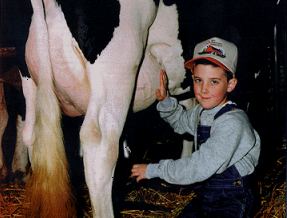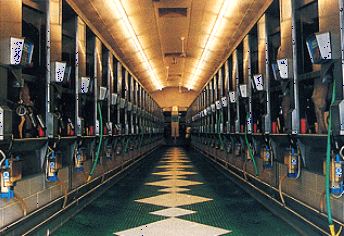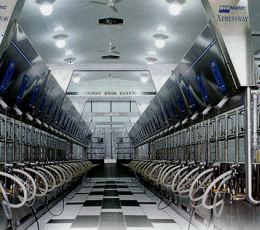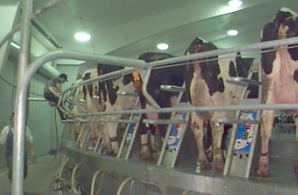|
 |
 |
Milking
Parlors
 Cows are milked twice per day on most farms. However, 10% increased milk
production can be obtained by milking the cows 3 times per day, and many
dairy farms are beginning to do so. Some operations even milk a portion
of their cows 4 times per day. Cows housed in tiestall barns are often
milked in their stalls. A number of dairy farms, primarily those whose
owners are members of religious denominations that do not utilize electricity,
still milk cows by hand rather than with
milking equipment. These are not common and usually involve only a few
cows. The milk from such operations does not enter the fresh
milk market and is utilized only for manufacturing purposes. Most
cows milked in tiestall barns are either milked with bucket
milkers or pipeline milking systems. Milking
cows in tiestall barns is extremely labor intensive and requires much
stooping and bending. The desire to reduce this type of labor has led
to many types of milking parlor designs,
in which the milker need not bend to be at the level of the cows udder.
Cows are milked twice per day on most farms. However, 10% increased milk
production can be obtained by milking the cows 3 times per day, and many
dairy farms are beginning to do so. Some operations even milk a portion
of their cows 4 times per day. Cows housed in tiestall barns are often
milked in their stalls. A number of dairy farms, primarily those whose
owners are members of religious denominations that do not utilize electricity,
still milk cows by hand rather than with
milking equipment. These are not common and usually involve only a few
cows. The milk from such operations does not enter the fresh
milk market and is utilized only for manufacturing purposes. Most
cows milked in tiestall barns are either milked with bucket
milkers or pipeline milking systems. Milking
cows in tiestall barns is extremely labor intensive and requires much
stooping and bending. The desire to reduce this type of labor has led
to many types of milking parlor designs,
in which the milker need not bend to be at the level of the cows udder.
Some cows in the Midwest and
Northeast are milked in Tie Stall Barns.
- Hand Milking (Amish)
- Bucket Milkers
- Pipelines
(Image Source: Genex, CRI) |

|
Walk-through or step-up
parlors are often installed or retrofitted into existing tiestall
barns as a cost effective way of alleviating the demands of the milking
chore. In these parlors cows enter from the rear, step up onto an elevated
platform for milking, and then exit forward through a headgate. Walk through
parlors are inexpensive, but labor demands are still relatively high.
Walk-through Parlor |
|
Step-up Parlor |
|

Image Source: Midwest Plan Service |
| Herringbone Parlor |
One of the most popular types of parlors is the herringbone,
so named because the cows enter and stand next to each other, but face away
from the operator's pit at an angle. Milkers
attach the milking clusters to the teats from
the side of the cow, and to have better visual contact with the cow's udder
while she is being milked. It is usually easier to keep the milker positioned
properly beneath the cow's udder.

Image Source: Midwest Plan Service |
| Parallel Parlor |
Parallel parlors are similar to the herringbone
parlors except that cows stand perpendicular to the operator pit and the
cows are milked from the rear, between the cow's hind legs. Advantages are
that the cows stand closer together so the worker has to walk less between
cows that are being milked. Disadvantages are that the cow's tail is often
in the way and it may be a long reach for some milkers to reach the cow's
front teats.
 |
| Rotary Parlor |
Rotary parlors are gaining in popularity.
Some older styles of rotary parlors were not very efficient or dependable.
New ones, however, have proven to be a viable alternative for large dairy
farms. With the rotary parlor, the platform on which the cows stand moves
around, while the cleaners and milkers stand in one location. Milking cows
is still a demanding task, however, because the cows come by so quickly
that each task must be performed in about 10 to 12 seconds with no break
between cows.
No matter what kind of parlor is used, there are
some key components of milking
procedures that are followed in each. Namely, the cow's teats must
be thoroughly cleaned and dried, the milking equipment must be working
properly and attached properly, and the teats must be disinfected with
an approved teat dip following milking. This
is to prevent possible spread of mastitis from cow to cow. Similarly,
the milk must be handled
properly after it leaves the cow. It must be cooled to under 45 degrees
Fahrenheit within 2 hours of milking. Plate
coolers are often more efficient at cooling milk than bulk
tanks and are used on most farms. Bulk tanks manufactured after January
1, 2000 must be equipped with a recording thermometer so that the temperature
history of the milk can be monitored. A sample of milk from each bulk
tank accompanies the milk truck to the receiving plant. The milk undergoes
a battery of tests to assure that it is safe and of high quality before
it is accepted for processing. Dairy producers must meet specific requirements
for bacteria counts and somatic cells
(white blood cells) in milk; and they are paid a premium for high quality
milk. No added water or antibiotic residues
are allowed, under penalty of losing one's permit to sell milk.
 Back
to Dairy Main Menu Back
to Dairy Main Menu
|

